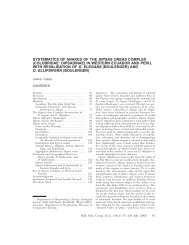cryptic species within the dendrophidion vinitor complex in middle ...
cryptic species within the dendrophidion vinitor complex in middle ...
cryptic species within the dendrophidion vinitor complex in middle ...
Create successful ePaper yourself
Turn your PDF publications into a flip-book with our unique Google optimized e-Paper software.
SPECIES IN THE DENDROPHIDION VINITOR COMPLEX N Cadle 235<br />
Cerro Delgadito, 2–4 mi W Santa Fe (Veraguas).<br />
Approximately 08u309N, 81u079W (GE).<br />
Cerro Malí (Darién). 08u079N, 77u149W (Fairchild<br />
and Handley, 1966). Accord<strong>in</strong>g to Myers (1969:<br />
25) Cerro Malí is about 1,410 m elevation and<br />
sou<strong>the</strong>ast of Cerro Tacarcuna and <strong>the</strong> headwaters<br />
of <strong>the</strong> Río Pucro (5 Río Pucuro; see Myers<br />
and Lynch, 1997, figs. 1 and 2). It lies at <strong>the</strong><br />
sou<strong>the</strong>astern end of <strong>the</strong> Serranía del Darién, a<br />
ridge separat<strong>in</strong>g <strong>the</strong> Pacific-dra<strong>in</strong><strong>in</strong>g Río Tuira<br />
system from <strong>the</strong> Atlantic lowlands of eastern<br />
Panama and nor<strong>the</strong>rn Colombia (<strong>the</strong> <strong>in</strong>ternational<br />
border follows <strong>the</strong> cont<strong>in</strong>ental divide along this<br />
ridge). Myers (1969: 24–25) described <strong>the</strong><br />
general topography and environment. Additional<br />
perspectives and details are <strong>in</strong> Anthony (1916,<br />
1923), Gentry (1983), and Myers and Lynch<br />
(1997).<br />
El Copé, cont<strong>in</strong>ental divide north of, 600–700 m<br />
(Coclé). The village of El Copé is at 08u379N,<br />
80u359W (Fairchild and Handley, 1966). El Copé<br />
(Omar Torrijos) National Park now encompasses<br />
<strong>the</strong> cont<strong>in</strong>ental divide.<br />
Isla Popa, south end of, 1 km E of Sumwood<br />
Channel (Bocas del Toro). Approximately<br />
09u099N, 82u089W.<br />
Laguna, 820 m (Darién). 08u049N, 77u199W (Fairchild<br />
and Handley, 1966). Accord<strong>in</strong>g to Charles<br />
W. Myers (personal communication), this locality<br />
is on a ‘‘ridge south of <strong>the</strong> Río Tacarcuna (upper<br />
tributary of Río Pucuro, Tuira dra<strong>in</strong>age).’’ Also<br />
referred to as ‘‘La Laguna,’’ it is not <strong>the</strong> village of<br />
<strong>the</strong> same name near <strong>the</strong> coast <strong>in</strong> southwestern<br />
Darién Prov<strong>in</strong>ce (e.g., as <strong>in</strong>dexed <strong>in</strong> <strong>the</strong> NGA),<br />
with which it is sometimes confused.<br />
La Loma, W Panama (Bocas del Toro). 08u509N,<br />
82u129W. Also known as Buenavista. 1,200 ft.<br />
elevation (366 m) on <strong>the</strong> Atlantic slope along a<br />
trail from Chiriquí Lagoon to David (Dunn, 1942:<br />
478).<br />
Pen<strong>in</strong>sula Valiente, Bluefields, 70 m (Bocas del<br />
Toro). 09u119N, 81u559W. Pen<strong>in</strong>sula Valiente<br />
delimits <strong>the</strong> eastern side of <strong>the</strong> Laguna de<br />
Chiriquí.<br />
Pen<strong>in</strong>sula Valiente, Quebrada Hido (Bocas del<br />
Toro). Not located.<br />
Pequení–Esperanza ridge, near head of Río Pequení,<br />
2,000 ft. [610 m] (Panamá). Approximately<br />
09u299N, 79u249W. Now <strong>with<strong>in</strong></strong> Parque Nacional<br />
Chagres. A ridge nor<strong>the</strong>ast of Lago Alajuela<br />
(Madden Lake), runn<strong>in</strong>g roughly nor<strong>the</strong>ast to<br />
southwest and separat<strong>in</strong>g <strong>the</strong> Chagres–Esperanza<br />
river system from <strong>the</strong> Pequení–Boquerón<br />
system (Dunn and Bailey, 1939: 4, 15). Cadle<br />
and Myers (2003: 15–17) described some of <strong>the</strong><br />
geography of <strong>the</strong> area as altered by damm<strong>in</strong>g<br />
associated with construction of <strong>the</strong> Panama<br />
Canal. Ibáñez et al. (‘‘1994’’ [1995], fig. 1)<br />
provided an outl<strong>in</strong>e map of <strong>the</strong> major rivers of<br />
<strong>the</strong> region.<br />
Pequení–Esperanza ridge, junction ma<strong>in</strong> divide,<br />
1,200 ft. [366 m] (Panamá). Approximately<br />
09u209N, 79u209W. Location not precisely <strong>in</strong>dicated<br />
by Dunn and Bailey (1939) but presumably<br />
at a lower elevation along <strong>the</strong> ridge closer to Lago<br />
Alajuela than <strong>the</strong> above-listed locality near <strong>the</strong><br />
head of <strong>the</strong> Río Pequení (see above cited<br />
references).<br />
Summit site, border of Darién, 320 m (San Blas).<br />
08u559N, 77u519W (coord<strong>in</strong>ates from <strong>the</strong> collector<br />
of FMNH 170138, Michael Duever). Also known<br />
as Camp Summit, a canal survey camp <strong>in</strong> <strong>the</strong><br />
Serranía del Darién discussed by Myers (1969:<br />
26–27, fig. 1), who gave <strong>the</strong> elevation as 358 m.<br />
LITERATURE CITED<br />
ALVAREZ DEL TORO, M. 1972. Los Reptiles de Chiapas.<br />
Segunda edition. Tuxtla Gutierrez, Chiapas, Mexico:<br />
Gobierno del Estado de Chiapas.<br />
ALVAREZ DEL TORO, M. 1982. Los Reptiles de Chiapas.<br />
Tercera edition. Tuxtla Gutierrez, Chiapas, Mexico:<br />
Instituto de Historia Natural.<br />
ANTHONY, H. E. 1916. Panama mammals collected <strong>in</strong><br />
1914–1915. Bullet<strong>in</strong> of <strong>the</strong> American Museum of<br />
Natural History 35: 357–376 + foldout map.<br />
ANTHONY, H. E. 1923. In <strong>the</strong> footsteps of Balboa.<br />
Natural History 23: 312–324.<br />
AUTH, D. L. 1994. Checklist and bibliography of <strong>the</strong><br />
amphibians and reptiles of Panama. Smithsonian<br />
Herpetological Information Service 98: 1–59.<br />
BARBOUR, T.,AND A. LOVERIDGE. 1946. First supplement<br />
to typical reptiles and amphibians. Bullet<strong>in</strong> of <strong>the</strong><br />
Museum of Comparative Zoology 96: 59–214.<br />
BELT, T. 1874. The Naturalist <strong>in</strong> Nicaragua, a Narrative<br />
of a Residence at <strong>the</strong> Gold M<strong>in</strong>es of Chontales;<br />
Journeys <strong>in</strong> <strong>the</strong> Savannahs and Forests; with<br />
Observations on Animals and Plants <strong>in</strong> Reference<br />
to <strong>the</strong> Theory of Evolution of Liv<strong>in</strong>g Forms.<br />
London: John Murray.<br />
BOLAÑOS, F., J. M. SAVAGE, AND G. CHÁVES. 2010.<br />
Anfibios y reptiles de Costa Rica (versión: 18 de<br />
Agosto del 2010). Listas Zoológicas Actualizadas<br />
UCR. San Pedro: Museo de Zoología, Universidad<br />
de Costa Rica. Available from: http://museo.biologia.ucr.ac.cr/<br />
Listas/LZAPublicaciones.htm. Accessed<br />
1 January 2011.<br />
BOULENGER, G. A. 1894. Catalogue of <strong>the</strong> snakes <strong>in</strong> <strong>the</strong><br />
British Museum (Natural History). Volume 2.<br />
London: British Museum (Natural History).<br />
CADLE, J. E. 2005. Systematics of snakes of <strong>the</strong> Dipsas<br />
oreas <strong>complex</strong> (Colubridae: Dipsad<strong>in</strong>ae) <strong>in</strong> western<br />
Ecuador and Peru, with revalidation of D. elegans<br />
(Boulenger) and D. ellipsifera (Boulenger). Bullet<strong>in</strong><br />
of <strong>the</strong> Museum of Comparative Zoology 158:<br />
67–136.<br />
CADLE, J. E. 2007. The snake genus Sibynomorphus<br />
(Colubridae: Dipsad<strong>in</strong>ae: Dipsad<strong>in</strong>i) <strong>in</strong> Peru and<br />
Ecuador, with comments on <strong>the</strong> systematics of<br />
Bullet<strong>in</strong> of <strong>the</strong> Museum of Comparative Zoology harv-160-04-01.3d 11/4/12 20:00:03 235







